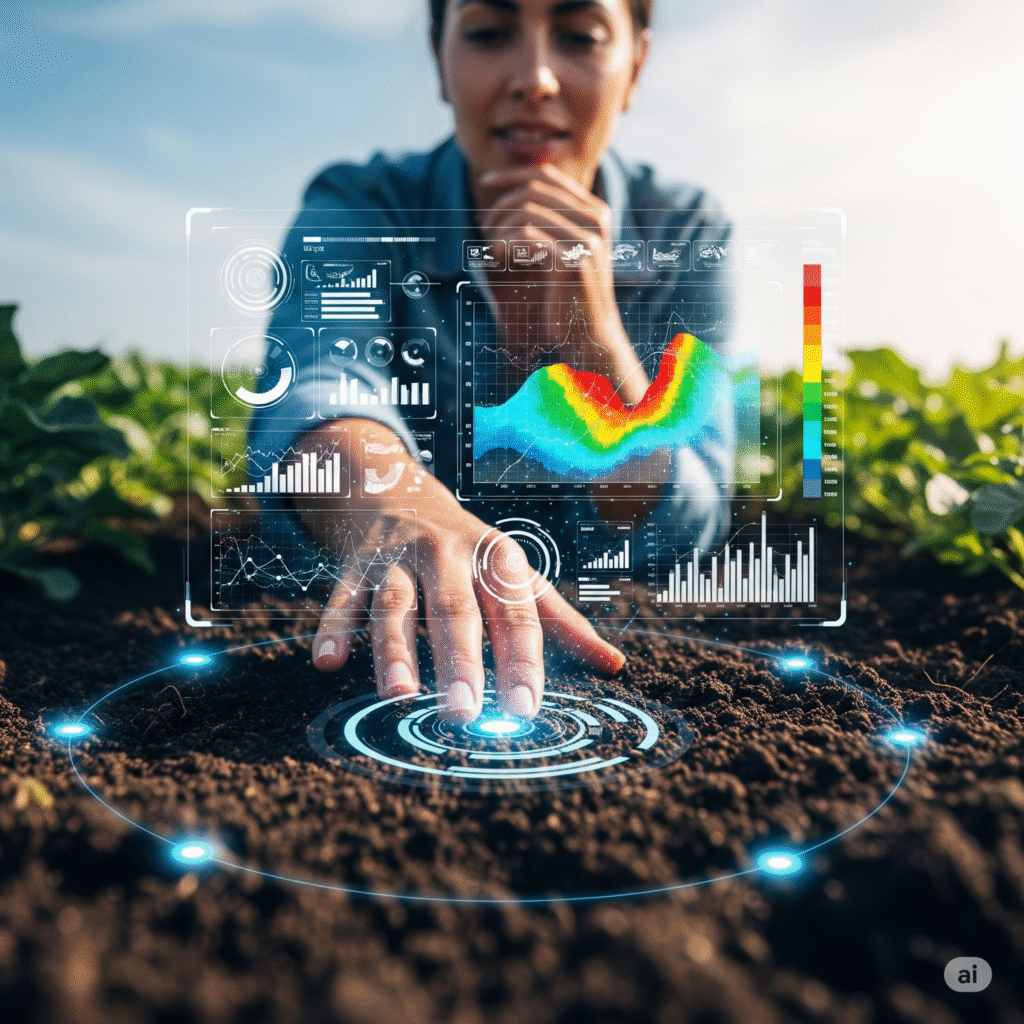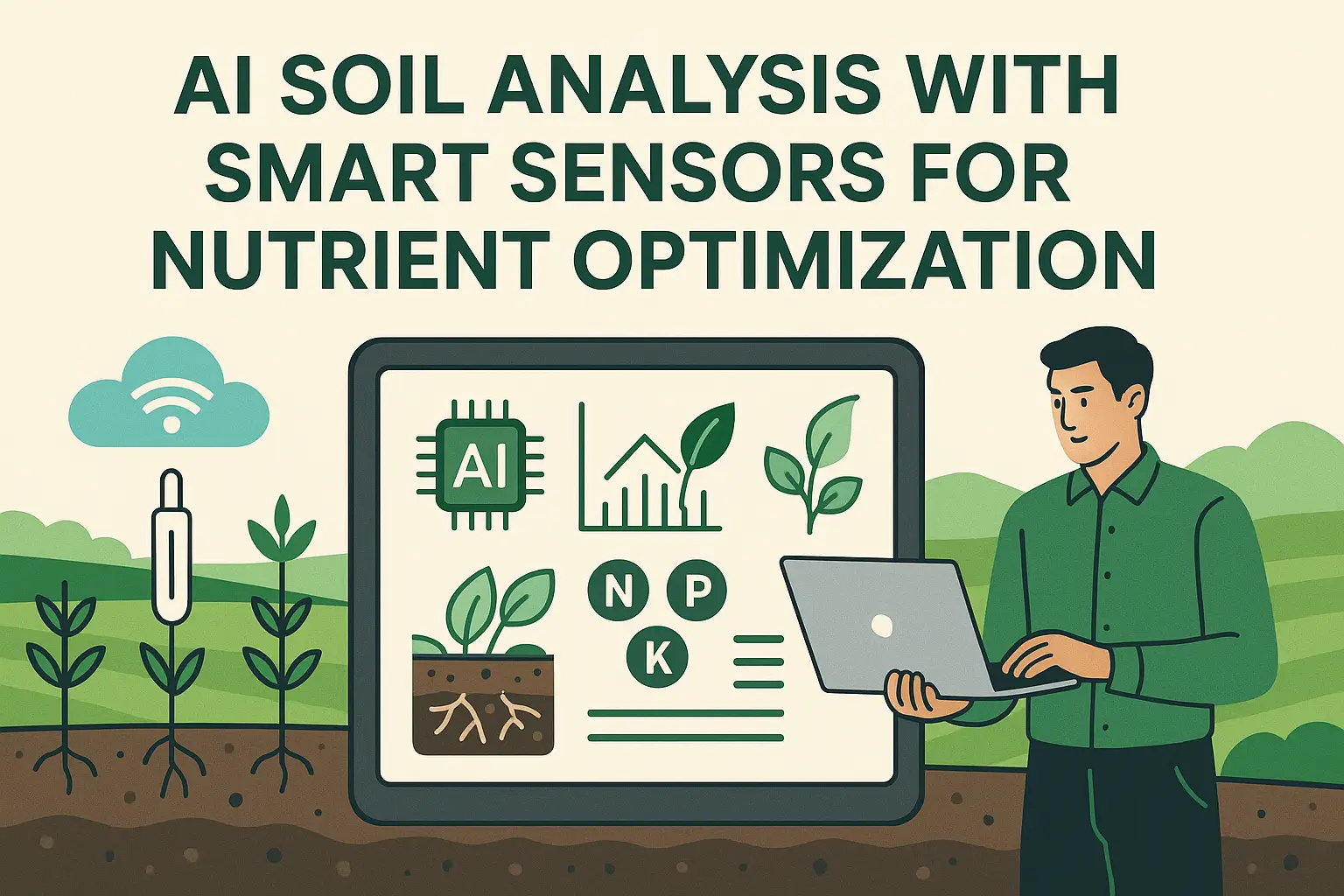Introduction
Agriculture is undergoing a digital revolution, with AI soil analysis emerging as one of the most transformative technologies reshaping how we grow food. Farmers, agronomists, and agricultural startups are leveraging smart sensors and AI to drive nutrient optimization, reduce input costs, and boost crop yields sustainably.
In this blog, we dive deep into how AI soil analysis works, the role of smart sensors, and how these technologies lead to efficient nutrient optimization. Let’s explore the future of farming—powered by data, intelligence, and the soil beneath our feet.
What Is AI Soil Analysis?

AI soil analysis refers to the use of artificial intelligence algorithms to collect, interpret, and make decisions based on soil data. Traditionally, soil analysis was manual, time-consuming, and subject to human error. But today, AI-powered systems can analyze large datasets in real-time, offering accurate insights into soil texture, pH, organic matter, moisture levels, and nutrient composition.
Farmers now receive predictive insights that help with crop planning, irrigation, and most importantly—nutrient optimization.
How AI Soil Analysis Works
At the core of AI soil analysis is data—vast amounts of it. Modern agriculture no longer relies solely on manual soil sampling or intuition. Instead, a network of technologies collaborates to collect, process, and interpret detailed insights about what’s happening beneath the surface. Through the integration of smart sensors, satellite imagery, drone surveillance, and historical agricultural records, AI systems can uncover patterns, trends, and anomalies that would be virtually impossible for the human eye to detect alone.
Key Components:
- Smart Sensors: These field-deployed sensors continuously monitor vital parameters like soil temperature, pH levels, moisture content, electrical conductivity, and nutrient composition. Some advanced sensors even detect microbial activity and organic matter presence, which further enhances data precision.
- AI Models: Once data is captured, AI and machine learning algorithms analyze it. These models are trained on extensive agricultural datasets and can simulate crop behavior under various conditions. They don’t just report what’s happening—they predict what’s likely to happen next and offer real-time recommendations based on current soil status and plant requirements.
- Mobile Dashboards: The interpreted data is delivered to the farmer via mobile or web dashboards that are intuitive and actionable. These interfaces often include color-coded maps, graphs, alerts, and suggested actions—empowering even non-technical users to make informed decisions.
This system operates in a continuous feedback loop. For instance, after applying fertilizer, the sensors detect changes in the soil, AI recalculates the response, and the dashboard updates the farmer. Over time, this leads to an evolving understanding of each field’s unique characteristics, enabling hyper-local, seasonally adjusted nutrient and irrigation strategies.
The Role of Smart Sensors in Soil Analysis

Smart sensors are the lifeblood of modern AI-driven agriculture. These compact, rugged devices embedded in fields or mounted on machinery act as the eyes and ears of AI systems. Without their constant stream of ground-level data, AI algorithms would lack the real-time context needed to generate accurate, field-specific insights. In essence, without smart sensors, AI would be flying blind.
Here’s how smart sensors contribute to soil analysis:
- Precision Monitoring
Sensors track critical variables such as:- Soil pH levels
- NPK (Nitrogen, Phosphorus, Potassium) concentration
- Moisture levels
- Electrical conductivity
- Temperature
- Salinity
This detailed information allows AI to assess soil health with surgical precision.
- 24/7 Feedback Loop
Unlike traditional soil sampling, which provides only a snapshot in time, smart sensors offer continuous, real-time updates. This enables farmers to respond quickly to environmental changes or nutrient imbalances before they affect crop performance. - Seamless Data Integration
Sensor data feeds directly into AI platforms where it’s aggregated, analyzed, and converted into actionable insights. This integration empowers systems to forecast soil behavior, anticipate future deficiencies, and guide dynamic nutrient management. - Alerts and Automation
When thresholds are crossed—such as low nitrogen or excess salinity—sensors can trigger automated alerts or even control irrigation and fertilization systems.
Additional Advantages:
- Minimal human intervention – Reduces manual errors and saves labor.
- High accuracy – Localized readings prevent overgeneralization from single-point sampling.
- Energy-efficient and wireless – Most modern sensors work on solar power or low-energy networks, reducing maintenance needs.
By deploying smart sensors strategically across various field zones, farmers gain a nuanced, real-time understanding of their soil. This results in more proactive, responsive, and precise management of resources, ultimately leading to higher yields and sustainable farming practices.
AI in Nutrient Optimization: Smarter Farming Begins Beneath the Soil
Modern agriculture requires a precise balance between meeting crop needs and protecting long-term soil health. Nutrient optimization—the process of delivering the right nutrients, at the right time, in the right amount—is critical for sustainable and profitable farming. Yet, traditional methods often rely on guesswork or outdated averages, leading to either nutrient overuse or deficiencies.
Over-fertilizing not only increases input costs but can also result in nutrient leaching, soil degradation, and environmental harm. On the other hand, under-fertilization causes stunted crop growth, poor yields, and long-term nutrient exhaustion. AI offers a transformative solution by enabling data-driven, site-specific nutrient planning that is responsive, efficient, and tailored to real-time field conditions.
Using data from smart sensors, satellite imagery, and historical crop performance, AI models deliver precise and localized nutrient recommendations.
Key Contributions of AI to Nutrient Optimization:
- Crop-Specific Recommendations
AI systems generate fertilization plans based on the nutrient demands of specific crops and their growth stages. - Optimized Timing
By considering weather forecasts, soil moisture, and plant development, AI identifies the ideal windows for nutrient application. - Micronutrient Management
AI can detect subtle deficiencies in trace elements like zinc, boron, or magnesium—nutrients often overlooked in traditional tests. - Input Selection
Based on soil composition and microbial activity, AI can recommend whether to use organic amendments or synthetic fertilizers for maximum effectiveness. - Dynamic Adjustments
Recommendations are not fixed. As new sensor data comes in, the AI adapts its guidance throughout the growing season.
According to a 2023 study in Agricultural Systems, farms that implemented AI-guided nutrient optimization reduced nitrogen use by 30% while increasing corn yields by 18%. These gains were achieved through smarter distribution and timing, not higher input volumes.
By shifting nutrient management from a reactive to a proactive model, AI helps farmers reduce waste, boost productivity, and protect the long-term viability of their land. This is not just a technological upgrade—it is a fundamental shift in how we approach agriculture from the soil up.
Benefits of Using AI Soil Analysis in Agriculture
Here are the key advantages of AI soil analysis:
1. Increased Yield
Predictive insights lead to smarter sowing, irrigation, and nutrient optimization.
2. Cost Reduction
Save on fertilizers, labor, and water through precision interventions.
3. Sustainability
Eco-friendly farming with reduced runoff and chemical overuse thanks to smart sensors and AI.
4. Faster Decisions
AI systems provide real-time dashboards—no more waiting days for lab reports.
5. Data-Driven Planning
Historical data is used to create planting calendars and forecast nutrient needs.
Each of these benefits is amplified when AI soil analysis is paired with smart sensors and actionable nutrient optimization models.
Case Studies: Real-World Applications of AI Soil Analysis
1. Small Farms in Maharashtra, India
In Maharashtra, the state government launched the MahaAgri-AI Policy 2025–2029 backed by ₹500 crore, integrating smart sensors, drones, satellite imagery, and AI-driven mobile apps to support farmers. One pilot project in the Vidarbha region employed AI soil analysis alongside real-time pest detection. Although not all farms used nutrient-specific sensors, the infrastructure rollout enabled cooperatives to pinpoint soil deficiencies through AI-backed spectral mapping. This led to a reported 35% reduction in fertilizer use and improved crop uniformity across smallholdings. The same initiative also facilitated real-time detection of the pink bollworm, helping protect cotton yields from significant damage.
2. Vineyards in Spain
Spanish wineries such as Pago Aylés in Zaragoza have deployed over 100 smart sensors to monitor environmental variables including soil moisture, temperature, atmospheric pressure, and wind data. Leveraging IoT platforms like Libelium and remOT technologies, AI systems generate predictive maps that enable early interventions to protect vine health. This technology has contributed to a 30% improvement in grape quality metrics and earned prestigious accolades such as the Grand Gold Bacchus award. In regions like Rias Baixas, the combination of multispectral drone sensing and AI has resulted in a 20% reduction in fungicide use and a 15% boost in productivity, leading to healthier vines and more sustainable viticulture practices (source).
3. Corn Belt, United States
In the U.S. Midwest, farms have experimented with AI soil analysis platforms that integrate drone multispectral imaging, smart sensors, and machine learning to monitor nitrogen levels in real time. These tools analyze the Normalized Difference Vegetation Index (NDVI) from UAV imagery alongside ground-based sensor data to predict soil nitrogen and moisture. One documented case demonstrated early detection of nitrogen deficiency during the vegetative phase, allowing timely corrective action that preserved the full corn yield cycle. Precision agriculture techniques such as GPS-guided variable-rate fertilizer application have significantly reduced fertilizer costs without compromising crop output (source, source, source).
Comprehensive Insights
Across these examples, a common thread emerges: the integration of IoT, remote sensing, and AI technologies enables:
- Data fusion: Combining satellite, drone, and sensor data allows AI to detect nutrient stress or pest/disease risk early, enabling precise intervention.
- Cost efficiency: Targeted applications such as reduced fertilizer use and necessity-based spraying yield substantial economic savings.
- Environmental gains: Optimized irrigation and lower pesticide use reduce chemical runoff, supporting more sustainable agricultural ecosystems.
These cases prove that AI-powered soil analysis is no longer hypothetical; it is actively transforming agriculture worldwide — from smallholder farms in India to premium vineyards in Europe and large-scale corn operations in North America.
Challenges and Limitations
While AI soil analysis is powerful, it’s not without limitations:
- Cost: Initial setup of smart sensors can be expensive.
- Data Literacy: Farmers need training to interpret dashboards.
- Connectivity: Rural areas may lack stable internet to support real-time AI analytics.
Despite these hurdles, global adoption is increasing rapidly due to the massive return on investment in the form of nutrient optimization and yield gains.
The Future of AI Soil Analysis and Smart Sensors
The next wave of AI soil analysis will be even more autonomous. Here’s what to expect:
- Edge AI: Smart sensors will process data locally, without needing internet connectivity.
- AI + Robotics: Robots will use AI soil analysis to conduct automated nutrient treatments.
- Blockchain + Soil AI: Transparent records for soil health tracking and carbon credit markets.
Startups are building decentralized platforms that combine AI soil analysis, weather data, crop patterns, and nutrient optimization models to support sustainable agriculture at scale.
Sources like Nature’s paper on AI in soil systems show promising potential in transforming soil health management globally.
Getting Started: Tools, Platforms & Best Practices
Recommended Tools:
- Teralytic: Advanced smart sensors for pH, NPK, and EC.
- Arable Mark 3: Combines weather and soil data with AI.
- CropX: A powerful platform for AI soil analysis with real-time dashboards.
Best Practices:
- Install smart sensors across varied zones in your field.
- Calibrate AI tools with local crop data.
- Use AI-generated insights to guide nutrient optimization and irrigation plans.
- Monitor continuously and adapt seasonally.
Check out our guide on shadow AI and unapproved AI tools to avoid pitfalls in implementation.
Conclusion
The convergence of AI soil analysis, smart sensors, and nutrient optimization is unlocking the next level of precision farming. It’s not just about collecting data—it’s about understanding your land like never before and making every decision count.
As technology becomes more accessible, even small farmers can reap the benefits of data-driven agriculture. Whether you’re managing a 2-acre plot or a 200-acre farm, investing in AI soil analysis is the most future-proof decision you can make today.

